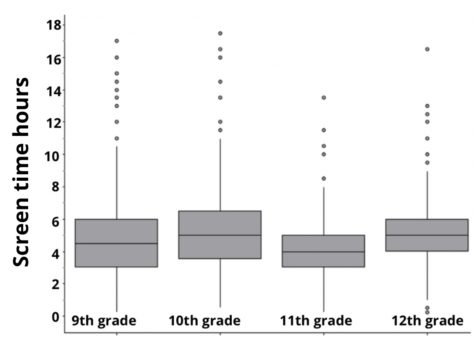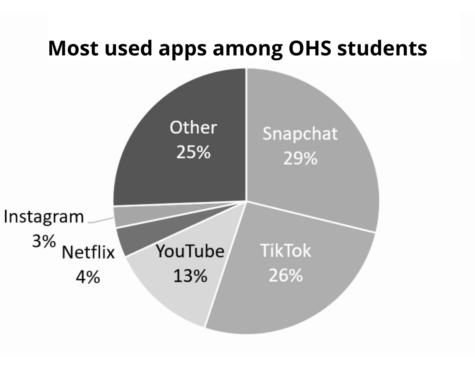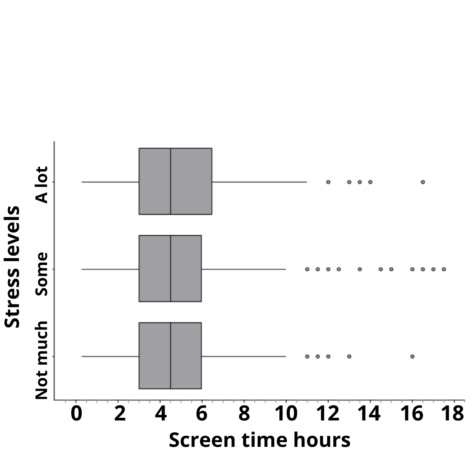Scrolling for answers on screen time
November 19, 2021

Mr. Will Fish, along with most OHS teachers, expected things to be a little different when students came back from distance learning. However, he noticed basic habits had changed; students were spending a lot more time on their phones.
On Wednesday, Oct 6. OHS assigned a survey on screen time during Compass time through Naviance. This survey was created by language arts teacher Mr. Will Fish and statistics teacher Mr. Steve Benson. This survey was anonymous and required students to fill out their grade and gender, average daily screen time, most used app, second most used app and how long they used those for. The survey also asked their approximate GPA and how much stress students feel relating to screen time and school work. Mr. Benson’s fourth hour statistics class then analyzed the data.
Statistically, the survey brought in an over half response rate bringing in 878 responses out of 1,492 students. This survey showed a non-response bias, meaning that to those students assigned not all were able or willing to participate.
The average screen time is four to five hours a day, with some students reporting up to eight to 18 hours on the higher end. This high screen time is a big issue since not all students even interact with people for five hours a day. The recommended screen time is no more than two hours per day. So how is this affecting students?

What apps are occupying the students’ time?
The top app among OHS students is Snapchat and on average it is used from one to two hours per day with each interaction being in 10-30 second intervals. The use of Snapchat is a constant cycle of picking up the phone and sending pictures back and forth. Based on this information it would mathematically equal to an average pick-up range from 200-300 pick-ups each day.
The second most used app is TikTok where students are spending an average of one to three hours each day. TikTok has one of the strongest algorithms, hooking viewers in for hours by showing them what they want to see.
Students spend hours watching TikToks without realizing how long it has been. School board student representative senior Daniela Ortiz said, “TikTok is the worst app ever, it is so easy to get distracted. I can spend hours on it and won’t even realize it, that is why I have to put a time limit for one hour and it surprises me every single time because I don’t realize how long it’s been. I always end up ignoring it and never actually stop, but at least it makes me aware of how much time I’m on it.”
Is screen time affecting students’ performance at school?
There is no correlation between the students’ screen time use and their GPA. The smartphone has become such a big part of students’ life that their grades are not affected by it. Students with a higher GPA have screen time ranging from zero to eight hours, as well as those with a lower GPA.

Stress levels and screen time
Mr. Benson’s statistics class found no correlation between stress levels and screen time, meaning that phone usage is not an issue in terms of stress. While students have higher stress levels it is not rooted in phone use as much as school work, keeping up with responsibilities, deadlines and social life balance.
Is higher screen time a problem? What is it affecting if it’s not affecting grades and stress levels?
Sleep is the main thing being affected by phone use. Staying up watching videos and being on social media is leading to poor sleep habits along with less energy throughout the day, as well as higher distraction. Screen time is affecting the way students hold relationships since valuable time is being spent on their phones instead of building relationships with the people around them. Phone use and social media makes students anxious since they have to see what is going on and what their friends are doing. Once students get in the habit of always checking their phone–even when it is away–it is still affecting the way they are thinking and it is affecting the way they process things. This takes away from their attention span and the ability to focus on something for a significant amount of time.
How is this affecting teaching?
At the beginning of the COVID-19 pandemic, students were told that electronic devices would become their greatest resources through online learning. After almost two years since it started a lot has changed, screens are incorporated into most in-person classes. Phones are a great resource in the classroom, but they should not be the center of attention. While he does not believe phones are a great companion, Mr. Fish believes they are an amazing resource. He said, “I think smartphones can be a useful tool and I like to see kids looking up words.” Most students will maintain a balance at school with their screen time, putting it away when teachers are lecturing and taking it out during their work time. Mr. Fish said, “There’s often a big difference between escape and exploration. If you’re exploring things and they’re useful things that’s great, if you’re just escaping I think we’re doing enough of that already.”
How can students manage their screen time?
The biggest factor in reducing daily screen time is self-control. While setting limits on apps is an amazing strategy, all limits can be taken off. A great way for students to reduce screen time is by turning off their phone for 30 minutes a day. This time can be used to read, take a walk, focus on schoolwork or spend time with family and friends.
One of the features provided on smartphones is putting limits on apps, after the time has passed a screen comes up with a notification and the user has two options, to ignore the limit for the day, or to remind them again in 15 minutes.
Students can clear out their phone of apps that are not worth their time, this is another way to reduce screen time, especially if they are not providing positive messages. Taking steps into reducing screen time is no easy thing to do as it is so engraved into everyone’s daily lives, but anything counts. It will take a lot of self-will but it will lead to a healthier and happier life.
